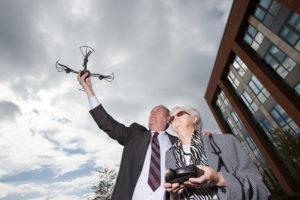82-year-old Limerick woman inspires US space exploration patent

An 82-year-old Limerick woman has inspired a US patent for an invention that could be used to help space missions succeed in the future.
Professor Mike Hinchey, director of Lero, the Irish Software Research Centre, led the research. “I overheard my Mum on the phone describing a project I was working on,” he explained. “She said that I was researching a system whereby a drone could chase after another one and fix it. I was working on no such thing but then I thought to myself, ‘Hey, that’s not such a bad idea’.”
Professor Hinchey, who also acts as consultant to NASA, applied the concept to space exploration vehicles that travel in swarms. Elements of those that fail can be used to support the rest of the fleet.
“The system is not unlike the behaviour of bees who sacrifice themselves for the sake of the colony.”
Now his mother, Delia Hinchey, is listed in the US as a co-author of the patent alongside Professor Hinchey; fellow Lero researcher Emil Vassev and Artificial Intelligence expert Roy Sterrit.
“Swarm based missions may be the wave of the future, whereby space exploration is undertaken not by one large spacecraft but by swarming formations of much smaller, cheaper ones,” says Professor Hinchey explained. “Future space probes that operate in cooperative swarms must self-sacrifice if they begin to fail and risk damaging their neighbours.”
Outlining how the concept could be used, Professor Hinchey said: “Refuelling of aircraft in the air is commonplace in military applications, but is limited to fuel rather than recharging and involves a specialised component carrying fuel solely for this purpose. Our patent however, relates to parts of an autonomic system, which donates a power provision such as battery, fuel, solar panel, or the like to another component to ensure the continued operation of the receiving module, even at the cost of self-sacrifice.”
Mrs Hinchey added: “It’s all a bit beyond me but I’m delighted I sparked something which might be of value to space exploration in the future.”